Alan Durning lays out how many cities have succeeded in building affordable housing with some lessons from unexpected places. Yet constrained housing markets come about from economics, environment, and geography, and sprawl remains a scourge that affordable cities have allowed. No silver bullet here, but ideas…
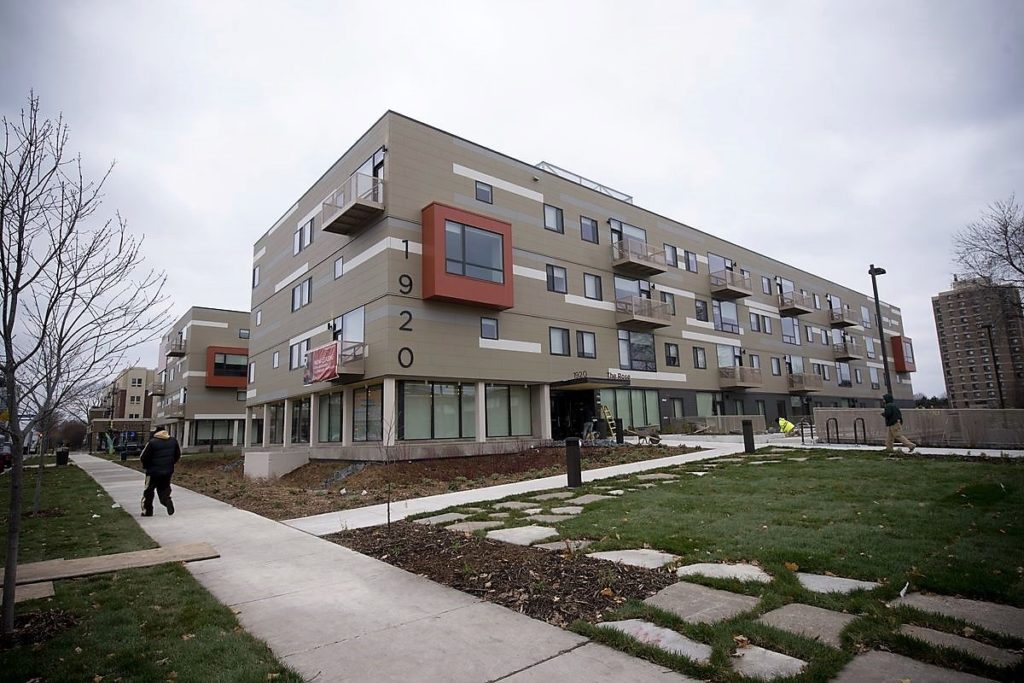

Yes, You Can Build Your Way to Affordable Housing
By Alan Durning, Published in Sightline Institute
“You can’t build your way out of a housing affordability problem.” That’s conventional wisdom. I hear it all the time: Prosperous, growing, tech-rich cities from Seattle to the Bay Area and from Austin to Boston are all gripped by soaring rents and home prices.
But what if you can build your way to affordable housing? What if, in fact, building is the only path to affordable housing? What if cities around the world have been building their way to affordability for decades?
You can. It is. And they have.


Consider Houston
There—even before Hurricane Harvey wrecked havoc on the housing stock in August—housing cost less, adjusted for inflation, than it did in 1980, as this Economist graphic illustrates. The median price of a single-family house in Harris County, Texas, which surrounds Houston was $141,000. In King County, Washington, which surrounds Cascadia’s first city of Seattle, the median-priced home now costs $658,000, more than four-and-a-half times as much.
Unchecked Urban Sprawl Coupled with Fossil Fueled Climate Change are a Recipe for Disaster, Suffering, and Financial Mess: “Two massive, rain-soaked cities on opposite sides of the world are struggling with swirling, brackish waters that have brought death and devastation. For Houston, it’s unprecedented. For Mumbai, it’s painfully common.” Let’s learn how never to become like Metro Houston, ever…
And Houston is no rust-belt basket case of decay and out-migration. It is the fourth largest city in the United States, among the fastest growing, and likely to rebound with surprising rapidity from the armageddon storm that just struck it. It’s also the most diverse large metropolitan area in the country, a demographic forerunner of the United States overall, with no ethnic or racial group in the majority. (Unlearn some of your stereotypes about Houston in Ed Glaeser’s Triumph of the City, this recent article by Nolan Gray, or this eye-opening lecture by Rice University sociologist Stephen Klineberg.) Houston has built its way to affordable housing.
Of course, the way Houston has achieved such extraordinary affordability may not suit Cascadia: it has sprawled. That’s not all it’s done. It’s grown much taller in its core, enabling housing construction everywhere, both dense and sprawling, with little red tape or delay. It’s no libertarian dreamscape: covenants, setback requirements, and off-street parking quotas temper private property rights, but it has no conventional zoning, and compared with other North American cities, it’s much more welcoming of homebuilding. Partly as a consequence, it has spread across an enormous area: you could fit all of the cities of Baltimore, Chicago, Detroit, and Philadelphia simultaneously inside the city limits of Houston. Greater Houston covers an area the size of the state of Massachusetts, despite the fact that Houston’s suburbs do have conventional zoning. Professor Klineberg calls it, “the most spread out, least dense, most automobile-dependent city in America.” Automobile dependence is expensive, and if you add the cost of transportation to the cost of housing, Houston’s advantage shrinks some—but not by three-quarters. Greater Houston is still a screamingly inexpensive place to live compared with Cascadia’s big cities.
The question left after examining Houston is not whether you can build your way to affordable housing, but whether you can do it without sprawling. The answer, again, is yes, you can.
STORY: Pruitt Igoe Myth: The Death of 20th Century US City


Consider Tokyo
The largest city in the world, with a metro-area population of 38 million, Tokyo is one of the world’s densest, most transit-oriented, lowest-carbon urban agglomerations. Given its size, you’d expect the Japanese capital to be expensive, because population size itself tends to raise housing prices. More people bidding on housing raises its cost.
Growing populations, at whatever size, also tend to raise prices, because home construction often cannot keep up with demand. And Tokyo itself is growing, even though Japan overall is not. Yet despite these trends, which would be expected to jack up prices, housing in Tokyo is a bargain. A detached, single-family home in a close-in prefecture of Tokyo might sell for $300,000, less than half the $748,000 median home price in the city of Seattle. What’s more, rent in Tokyo has decreased in the past decade, as building has actually outpaced population growth, according to Next City.
The reason for Tokyo’s affordability? Like Houston, Tokyo makes home construction extremely easy, imposing few legal barriers and rarely delaying construction with red tape. Japanese zoning rules give property owners enormous flexibility. Takahiro Noguchi, head of the planning section in Tokyo’s Minato ward, told Robin Harding of the Financial Times, “People have the right to use their land so basically neighboring people have no right to stop development.” And build they do! In Tokyo proper, with a population of 13 million, builders started construction of more than 142,000 homes in 2014. That’s far more than the 84,000 new homes started that year in the entire state of California, which has three times the population, as Harding reports.
Tokyo’s homes may be smaller than Cascadia’s, but they’re growing. Residential space per person has doubled in Tokyo over the last 50 years. Some critics dislike Tokyo’s unplanned, eclectic neighborhoods or balk at the idea of a high-rise metropolis (which is a misperception about Tokyo anyway). But if Houston proves you can build your way out of an affordability crunch, Tokyo proves you can do it in a dense, walkable, transit-oriented form. Tokyo’s per-capita carbon dioxide emissions are one fourth of Houston’s and a third of those from western US cities such as Denver and San Francisco.
I repeat: Tokyo, the world’s largest city, is much cheaper than Cascadia. It has built housing faster than its population has grown, and it has grown denser along the way.
Of course, Tokyo has a radically different land-use governance system, with strong national control and little influence for neighbors. “Local government,” says Junichiro Okata of University of Tokyo, “has almost no power over development.”
Meanwhile, Houston is the great exception to North American zoning regimes, with no conventional zoning at all inside city limits. What about more typical cities? Can you build compact, walkable cities that are affordable under conventional North American zoning?
Still yes.
STORY: Shipping Containers as Sustainable, Affordable Housing?
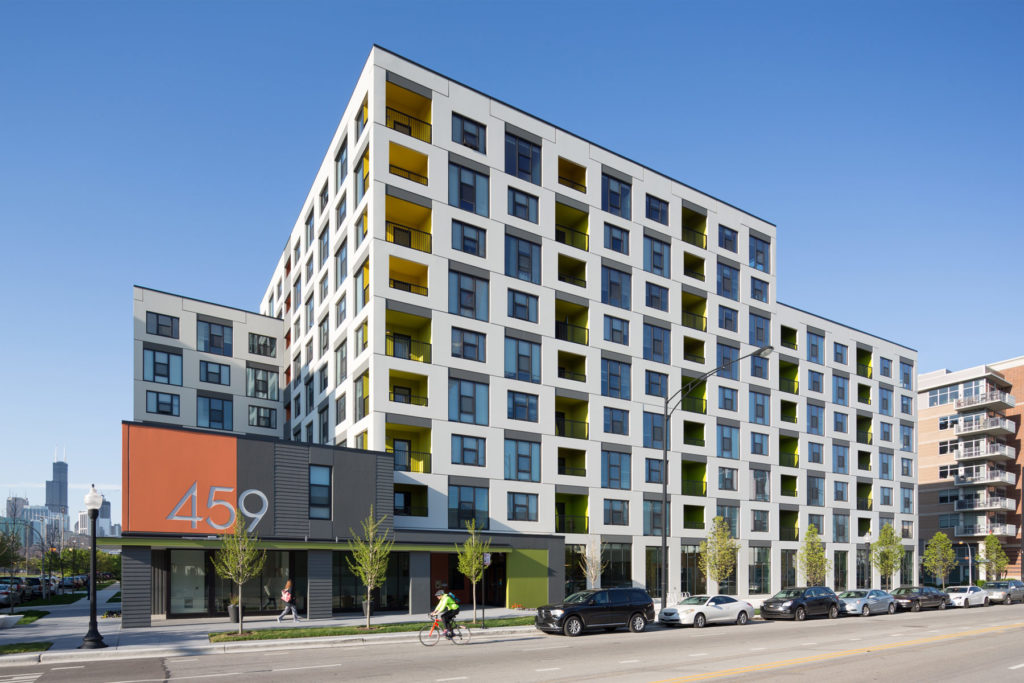

Consider Chicago
As the figure below illustrates, both rental and for-sale homes in greater Chicago are, if not as cheap as in Houston, still available at fire-sale prices compared with Seattle (to say nothing of San Francisco). As of May 2017, the median price per square foot of a home in Chicagoland was just 55 percent of greater Seattle’s price. Rent was one-quarter lower too, though Chicago’s population is almost three times bigger than greater Seattle’s.
Since 1990, greater Chicago, unlike many Midwestern cities, has been adding population (though in the last two years, it’s lost an increment). Chicago is conventionally zoned and governed, but its pro-housing policies—faster permitting, less-restrictive zoning—make homebuilding far easier and housing choices far more numerous than in many similarly blue US cities. “Between 2002 and 2008,” writes economist Ed Glaeser in Triumph of the City, “Chicago issued 68,000 housing permits . . . [while] Boston issued 8,500 housing permits. . . . Chicago issued more than three times as many housing permits as San Jose, California, a city that is almost as large and far less dense.” Chicago’s story is not exclusively one of abundant housing choices; it’s also growing more slowly than Seattle, for example, and its growth is concentrated in the densifying urban core. Still, compared with other great North American cities, it’s doing a good job of keeping up with demand without simply sprawling to the four directions.
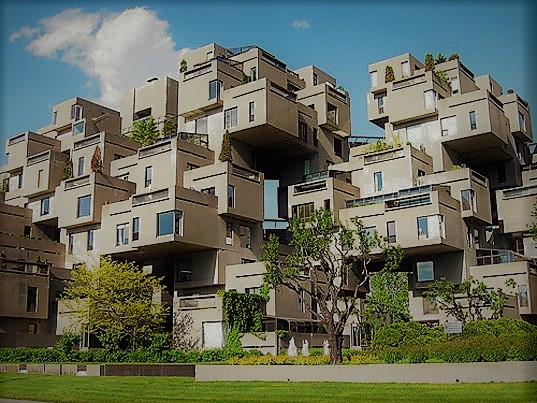

Consider Montreal
Canada’s second most populous metro area is vastly less expensive than greater Vancouver, BC—less than half as much for a typical house. It’s even cheaper than much-smaller cities such as Saskatoon. Part of the explanation, as in Chicago, is that population is growing more slowly than in Cascadia’s large cities and their tech-booming counterparts elsewhere. But this difference amounts to less than you might think. For one thing, Montreal is growing, as traffic engineer and Montreal blogger Simon Vallee points out: Montreal in recent years has grown 1.2 percent a year, while Vancouver has grown 1.3 percent a year. Not a staggering difference! More important is that greater Montreal keeps building residences, adding more homes over the last decade not only than Vancouver, BC, but also than similarly sized US metro areas such as Seattle and San Francisco, according to US and Canadian census data.
Beyond the numbers alone, Vallee argues, is that much of the metropolitan area is dominated by land zoned for low-rise—typically three-story—flats and mid-rise apartment buildings. Montreal’s zoning is the inverse of Portland, Seattle, and Vancouver’s. The latter give most of their land to detached single-family houses, then concentrate high- and mid-rise buildings along arterials and in pockets. Montreal gives most land to low- and mid-rise apartments, and little land to detached, single-family houses or expensive-to-build high-rises. Instead, it builds three-story walkup apartments and the like by the square-mile section, both in the city and the suburbs: such neighborhoods are dense enough to support transit, cycling, and walking and are also made up of the cheapest form of housing to build and operate. Overall, metropolitan Montreal is the second densest city in Canada, trailing greater Toronto by a whisker and substantially leading greater Vancouver, despite the famous skinny residential towers of the latter’s downtown skyline.
Montreal demonstrates the power of “missing middle” housing on a massive scale.
In the cities I’ve mentioned so far, private enterprise has supplied the homes, but building your city all the way to affordability does not necessarily require that. What matters is building enough homes for all the people who want to live there, not whether the builders are private, public, or a blend.
STORY: Landscape Urbanism: Green Roofs, Community Farms in Japan
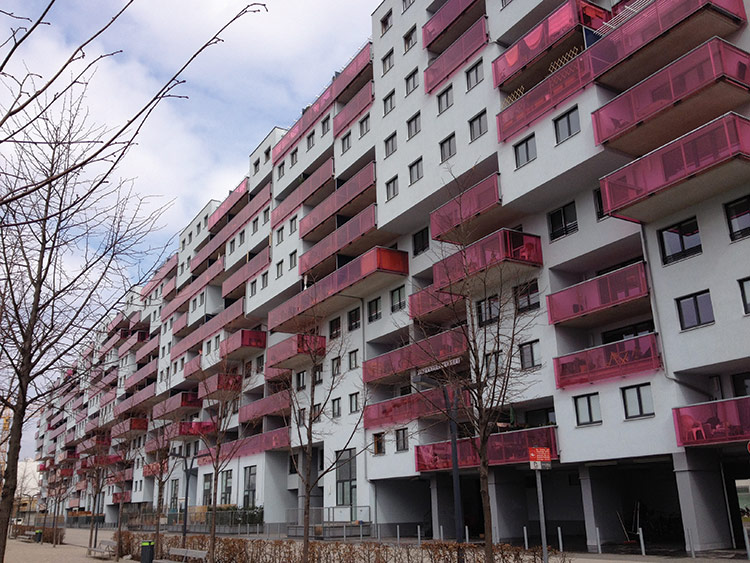

Consider Vienna
There, a far-left government in the 1920s, began erecting vast new housing blocks in structures and complexes designed by leading architects and admired by urbanists to this day. This cityscape, plus later generations’ additions, now accommodates some 62 percent of the city’s population: a cumulative total of 220,000 municipal rental units along with a similar number of dwellings owned by limited-profit housing associations. Some 70 to 80 percent of new housing construction in Vienna is publicly subsidized, as it has been for many years. In Cascadia, the equivalent figure for existing buildings is in single digits: in Seattle, for example, it’s about 8 percent.
Compared with Seattle (or Vancouver), Vienna’s housing is much denser: the city is mostly apartments and lacks even one acre of single-family zoning. At the same time, its parks and open space are four times as ample, covering half of the city. And its development process is both more streamlined and more participatory. Most housing is developed through competitions among developers, judged by committees of experts based on a set of criteria. Among these criteria are social cohesion and integration (to make racial, nationality, and class disparities matter less), environmental sustainability, beauty, and community. Because Vienna’s dense, walkable neighborhoods mix incomes, nationalities, and races, they provide more equitable access than Cascadian cities to parks and public spaces, public schools and libraries, and job openings: the Viennese housing market does not ration opportunity the way Cascadia’s housing market does.
Vienna’s housing model is impressive, if no panacea. Of course, the city, like Tokyo, operates in a completely different political context than Cascadia. City government controls huge areas of land, which it can award to homebuilders with strings attached. Rental laws nationwide in Austria function like rent stabilization programs, giving tenants predictability. At the same time, home ownership is rarely a path to financial gain in Austria, and private property rights are less sacred than in North America. Massive expenditures from the national government bolster Vienna’s housing. (Astute observers may note that the same is true in the Northwest states, through the US mortgage interest deduction and other tax preferences, which funnel hundreds of billions of dollars to US homeowners. The difference, of course, is that Austria subsidizes construction of housing, while the United States subsidizes mortgage borrowing. Naturally, Vienna gets more homes, and the Northwest gets more mortgage debt. Furthermore, in Austria, the subsidies increase as you go down the income ladder, while the US subsidies flow up the ladder.)
Vienna’s political left, unlike Cascadia’s, actively supports housing construction, perhaps because homebuilding in Vienna is not a conventional, profit-seeking business but is a closely regulated industry, almost a public utility. Consequently, with ample political support, housing construction usually keeps up with demand in Vienna; the city gains far more new dwellings each year than does Seattle, for example, despite similar population growth.
And Vienna is not the extreme case of government-led housing abundance.
STORY: Buckminster Fuller’s World of Sustainable Design
httpvh://youtu.be/Ya69WuHcq8M
The Interlace apartments, Singapore, by OMA/Ole Scheeren – high-end design that’s affordable
Consider Singapore
The city-state surrounded by Malaysia goes even farther than Vienna: some 82 percent of residents live in apartments built by the state Housing Development Board, and nine-tenths of them own those apartments, purchased—curiously—out of their social security accounts. As in Vienna, public subsidies flow disproportionately toward the bottom rather than the top of the income ladder. Unlike in Vienna, though, the state housing board is not only builder or subsidizer of apartments but also the mortgage banker and even law enforcer: failure to pay parking tickets can get you evicted.
Singapore is a jaw-dropping story: nearly a million publicly built homes, in a short period, erected in dense, walkable, transit-oriented, energy-efficient, highrise “new towns,” surrounded by parks and green space (more here and here). Housing prices are modest, and housing policy leads to greater social equity, not widening wealth gaps. But of course, Singapore is a political outlier, a technocratic government with authoritarian tendencies that’s been under one-party rule for a half century. Singapore’s housing model seems inseparable from its political system, so it’s likely not replicable in Cascadia?
One more example with lessons, but this time from neither a city nor a city-state but a large nation:
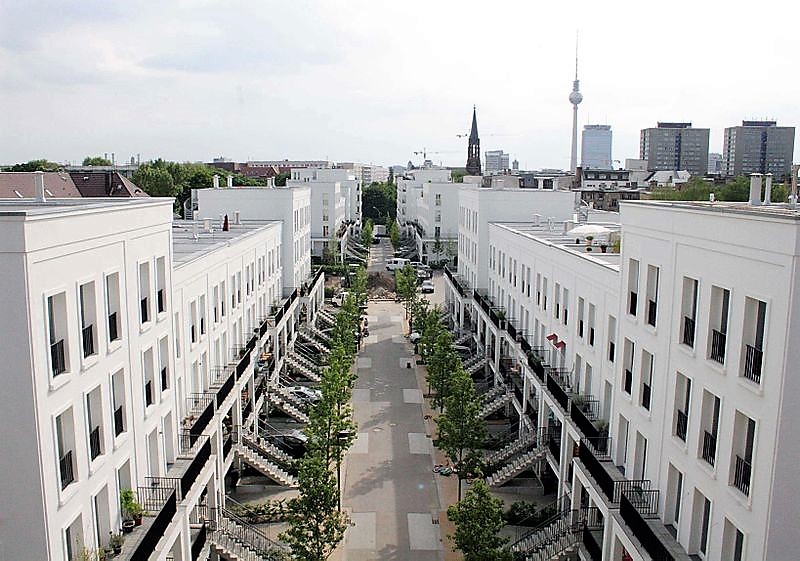

Consider Germany
Housing prices are dramatically lower in Europe’s cornerstone economy than in hot housing markets elsewhere in Europe or North America: more like Houston than San Francisco or London. Like in Houston, German home prices have declined, not increased, over the past three decades. The explanation is that Germany encourages homebuilding, lots of it. For each increment of population growth in recent years, for example, Germany has built three times as many new homes as has the United Kingdom. For one thing, public funding flows to local government in proportion to local population, so local agencies have a strong incentive to make land available for housing and to keep regulations tuned for efficiency. Economics blogger Steve Waldman writes:
Germany’s path is ideologically mixed. On the one hand, German property owners have a right to build within broad planning parameters. On the other hand, what we in the United States call rent controls are universal in Germany. . . . Lending for home buying is regulated and conservative in Germany, preventing joint credit/housing booms. . . . Homeownership and renting are roughly balanced, and home prices have had no tendency to increase dramatically. Homes in Germany are what a naïve economist might predict they should be, a very durable consumption good that provides a stream of housing services, not a ticket to financial gain at all.
Germany, like Austria, stabilizes rents through its lease laws. It does so without the collateral damage to housing choice that rent control has typically brought in North America, because other German policies consistently encourage building enough homes for all. When homes are abundant, Germany teaches Cascadia, rents remain stable anyway, so regulatory limits on rent increases provide peace of mind to tenants without appreciably undermining incentives for builders.
Lessons from unexpected places
Houston, Tokyo, Chicago, Montreal, Vienna, Singapore, Germany—all these places have built their way to affordable housing. They’re not alone. Housing economist Issi Romem has detailed the numerous U.S. metro areas that have done the same: Atlanta, Charlotte, Dallas, Las Vegas, Orlando, Phoenix, Raleigh, and more. Many more. They have done so mostly by sprawling like Houston.
In fact, Romem’s principal finding is that US cities divide into three groups: expansive cities (sprawling cities where housing is relatively affordable such as those just listed), expensive cities (which sprawl much less but are more expensive because they resist densification, typified by San Francisco), and legacy cities (like Detroit, which are not growing).
Romem’s research makes clear that the challenge for Cascadian cities is to densify their way to affordability—a rare feat on this continent. Chicago and Montreal are the best examples mentioned above.
In Cascadia’s cities, though, an ascendant left-leaning political approach tends to discount such private-market urbanism for social democratic approaches like that in Vienna.
Unfortunately, the Vienna model, like the Singapore one, may not be replicable in Cascadia. Massive public spending and massive public control work in both Vienna and Singapore, but they depend on long histories of public-sector involvement in housing plus entrenched institutions and national laws that are beyond the pale of North American politics. No North American jurisdiction has ever come close to building enough public or nonprofit housing to keep up with aggregate housing demand. This statement is not to disparage subsidized housing for those at the bottom of the economic ladder or with special needs. Cascadia’s social housing programs provide better residences for hundreds of thousands of people who would otherwise be in substandard homes or on the streets.
But acknowledging the implausibility of the Vienna model for Cascadia may help us have realistic expectations about how large (well, small) a contribution public and nonprofit housing can make in solving the region’s housing shortage writ large. Accepting that reality may help us guard against wishful thinking.
Because adopting a blinkered view of housing models is dangerous. Adopting the view that Vienna, for example, is the one true path to the affordable city—a view that fits well with a strand of urban Cascadia’s current left-leaning politics, which holds that profit-seeking in homebuilding is suspect and that capitalist developers, rather than being necessary means to the end of abundant housing, are to be resisted in favor of virtuous not-for-profit or public ventures—runs the risk of taking us to a different city entirely.
In the political, legal, and institutional context of North America, trying to tame the mega-billion-dollar home building industry—and the mega-trillion dollar real-estate asset value held by homeowners and companies—in order to steer the entire housing economy toward a Viennese public-and-nonprofit model may end up taking us not to Vienna at all but to a different city. It might end up delivering us to San Francisco. So . . .
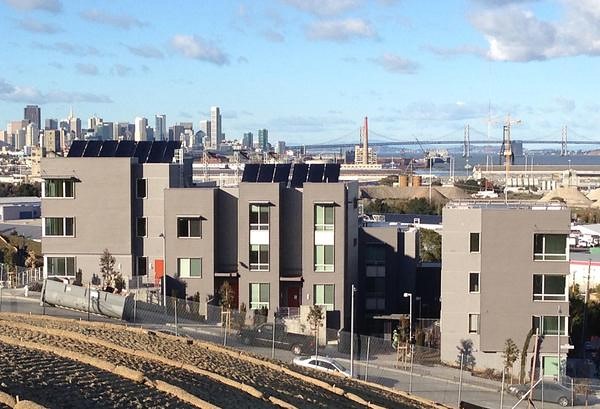

Consider San Francisco
A city bifurcated between rich people in multi-million-dollar homes and multi-thousand-dollar apartments, poor people in nonprofit or public housing, and a slim slice of middle-class people in old and deteriorating rent-controlled apartments that they inhabit by virtue of inheritance, luck, or extreme persistence; a city that has averaged the addition of little more than 1,500 new dwellings a year for decades, when at least three times that many would have been needed to keep up with the tsunami of would-be neighbors, according to planning research and advocacy group SPUR—San Francisco is so severely afflicted by a self-imposed housing shortage that, as noted in the figure above, home prices per square foot are almost six times higher than in Houston and more than twice as high as in still-astronomical Seattle. Rents too are massively elevated.
San Francisco is the second city of the U.S. West. It centers what may be the biggest innovation- and wealth-generating agglomeration of people on Earth. The information revolution is issuing like an economic waterspout from the San Francisco Bay area. Yet the municipalities that make up the greater San Francisco Bay area have permitted the construction of just 14,752 new homes a year, on average, from 2006 to 2016, according to data from the US Bureau of the Census (combining the San Francisco and San Jose Census Metropolitan Statistical Areas). During the same period, greater Houston—which has the same population, or did by the end of this period—built more than three times as many homes, some 47,616 a year. Adjusting these figures for population shows a similar result: Over the same period, the Bay Area averaged 2.3 new dwellings per year for every 1,000 residents, while greater Houston averaged 7.9—a 3.4-fold margin.
Part of the problem in California is the perverse and pervasive effects of the 1978 tax revolt ballot measure Proposition 13, which slashed, froze and distorted property taxes statewide, granting long-time homeowners huge windfalls while penalizing cities for allowing new dwellings, but not new offices and stores, within their borders (for example). This policy also severely constrains the turnover of houses from one owner to the next. But more of the problem is misguided neighborhood obstructionism.
I won’t belabor the point. The housing travails of the City by the Bay have been told well and often. The key lesson of San Francisco is that the city’s own closely held social-democratic values have made the city a housing nightmare, as artfully explained by Gabriel Metcalf of SPUR. The same dynamic comes through strongly in journalist Kim-Mai Cutler’s tour de force “How Burrowing Owls Lead to Vomiting Anarchists (Or SF’s Housing Crisis Explained).” San Francisco’s anti-developer politics have dug it into a self-perpetuating cycle of self-righteousness and displacement.
San Francisco’s lesson for Cascadian cities is that Viennese-style values are not enough. To replicate Vienna’s affordable housing model, a city would also need Vienna’s history, legal powers, and national revenue. Lacking those things, San Francisco has succeeded only in starving itself of housing, not building a housing economy that lives out its progressive values. It has the power to stop private developers from building enough homes, but it does not have the power to build them itself.
A different, hybrid model is called for in Cascadia, one that can work in Cascadian context, one that harnesses the private sector to public ends. Which is not to say lessons from Vienna are not transferable. They are. Where large blocks of public land are available, for example, Cascadia too could develop them through design competitions among developers. Vienna’s zoning and open space policies are inspiring, too: Vienna achieves beautiful density combined with vastly more natural spaces than Cascadian cities.
But the lessons of other places are just as relevant. Houston, for example, can be Cascadia’s model for how easy it ought to be to get permits to build homes—if we believed, as Houston does, that building homes is in itself a good thing, our permitting processes would encourage rather than discourage it through endless months of hoop-jumping and politicized reviews. Tokyo, meanwhile, reminds us that placing control over development at senior levels of government, and making development of urban property a right of its owner, helps to elevate the broad public interest in abundant housing choices over parochial opposition to change. (Leaders in California have recently succeeded in passing a raft of new laws to act upon this lesson.)
Yet: Between July and September, California Democrats, led by Gov. Jerry Brown and empowered by a two-thirds majority in both houses of the Legislature, have passed legislation that guts effective local control over climate change and housing development issues, arguably the two most pressing issues facing the people of California. … The Assembly approved Sen Scott Wiener’s SB 35, which deregulates market-rate housing development in California by requiring mandatory approval of all housing proposals if the regional housing needs targets for that county are not BUILT in a given year. — 48 Hills
Chicago teaches that a pro-housing political orientation can provide abundant housing even under conventional zoning in a deep blue city, while Montreal offers Cascadia a model of a cityscape no longer of single-family homes but of three-story rowhouses, walk-up apartments, and condominiums on quiet, tree-lined streets close to transit and neighborhood centers. Singapore’s lesson is the promise of erecting high-density, park-like “new towns” on underused city land. And Germany shows us that a future is possible where housing is no longer an investment vehicle but “a very durable consumption good that provides a stream of housing services, not a ticket to financial gain.”
More prosaically, one version of a Cascadian hybrid is what Seattle’s Housing Affordability and Livability Agenda (HALA) recommended in its 2015 report, and the city has been energetically if imperfectly implementing ever since: citywide upzones matched with affordable housing mandates, parking reforms, reliberalization of rooming house rules, legalization of in-law apartments and backyard cottages, and much more.
The larger lesson, though, comes not from the detailed HALA plans and proposals, but from all these places.
And it is simple: Yes, you can build your way to affordable housing. Aside from economic decline and depopulation, it is the only strategy that actually works. You can do it through a state monopoly as in Singapore, an array of public and limited-profit associations as in Vienna, or private developers as in Chicago, Germany, Houston, or Montreal. But to have affordable housing, you have to build homes in great abundance, and without that, other affordability strategies such as rent control and inclusionary zoning can be fruitless or counterproductive, as in San Francisco. Building plenty of housing is not just one way to affordability, it is the only way—the foundation on which other affordability solutions, measures against displacement, and programs for inclusion rest.
Thanks to Dan Bertolet and Margaret Morales for research assistance and to reviewers Joe Cortright, Kim-Mai Cutler, and Issi Romem for their helpful critiques. All remaining errors are attributable to the author.
Updated 4 October 2017












